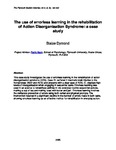The use of errorless learning in the rehabilitation of Action Disorganisation Syndrome: a case study
| dc.contributor.author | Dymond, B. | |
| dc.date.accessioned | 2019-05-15T13:34:58Z | |
| dc.date.available | 2019-05-15T13:34:58Z | |
| dc.date.issued | 2012 | |
| dc.identifier.citation |
Dymond, B. (2012) 'The use of errorless learning in the rehabilitation of Action Disorganisation Syndrome: a case study', The Plymouth Student Scientist, 5(2), p. 182-202. | en_US |
| dc.identifier.issn | 1754-2383 | |
| dc.identifier.uri | http://hdl.handle.net/10026.1/13990 | |
| dc.description.abstract |
This case study investigates the use of errorless learning in the rehabilitation of action disorganisation syndrome (ADS). Case DL suffered 2 traumatic brain injuries to the frontal lobes (2002 and 2010) and presents with a clear case of ADS. DL displays high levels of disorganisation when engaging in sequential tasks. Errorless learning was used in an attempt to rehabilitate abilities in two everyday routine sequential actions; making a cup of tea and making toast with butter and jam. Errorless learning involves the deliberate prevention of errors using both verbal and physical prompts. The intervention resulted in a significant decline in the number of errors made in both tasks, showing errorless learning as an effective method for rehabilitation in everyday action. | en_US |
| dc.language.iso | en | en_US |
| dc.publisher | University of Plymouth | |
| dc.rights | Attribution 3.0 United States | * |
| dc.rights.uri | http://creativecommons.org/licenses/by/3.0/us/ | * |
| dc.subject | action disorganisation syndrome | en_US |
| dc.subject | error less learning | en_US |
| dc.subject | traumatic brain injuries | en_US |
| dc.title | The use of errorless learning in the rehabilitation of Action Disorganisation Syndrome: a case study | en_US |
| dc.type | Article | |
| plymouth.issue | 2 | |
| plymouth.volume | 5 | |
| plymouth.journal | The Plymouth Student Scientist |



